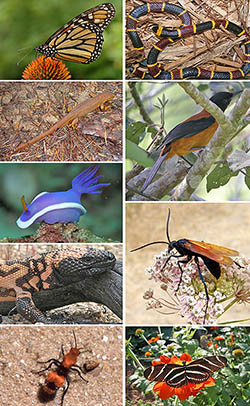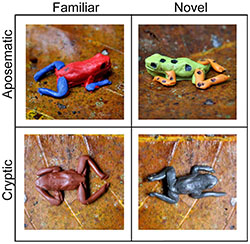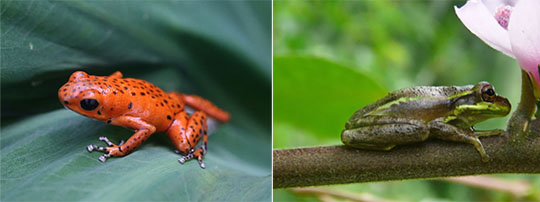
Is It Easy Being Green?
What's in the Story?

Imagine you’re a frog in the rainforest. You love living there, but you always have to be aware of looming birds, snakes, and other hungry animals that want you to be their next meal. Luckily for you, you are poisonous and this helps protect you from predators. The question for you is - should you be dull or brightly colored? If you are dull and blend in with your background it would be harder for predators to see you. If you are brightly colored you can warn attackers of your poisons. If you are like many frogs that are poisonous, you choose to be bright and colorful. Your next question is which colors will work best to keep you safe? Scientists wondered the same thing.
To answer our question, we could test what colors work best to protect frogs and warn predators of poisons, and then test how well brightly colored animals survive in the wild. One group of scientists did exactly this. In the PLOS ONE article, “Inferring Predator Behavior from Attack Rates on Prey-Replicas That Differ in Conspicuous,“ the scientists looked at poisonous frogs and how bright colors affect attacks on the animal.
Poison Dart Frogs: Don't Eat Them!

Poison dart frogs are bright and colorful amphibians found in Central and South America. Their name also tells part of the story. Native people of South America use the frogs’ poisons to coat their blow darts for hunting and for combat. These frogs' poisons are believed to be one of the most poisonous in the animal kingdom and potential predators like birds avoid attacking these frogs. Poison dart frogs come in many different patterns and colors. Could the different colors and brightness matter? Scientists proposed the hypothesis that frogs of one color get attacked less than other colors.
Play-Doh Frogs

To study if color and pattern stop bird attacks, the scientists used clay similar to Play-Doh to build a lot of frog models that look just like the frogs found in the jungle. The scientists made models of two frogs found in the jungle and two frogs not found in the jungle. Of the jungle frogs, one was bright red and the other model was a dull brown.
Of the non-jungle models, one was bright yellow and one was black. You may be thinking that a brown or black model would be very difficult for birds to see against a dark brown background in the jungle, and you are right! If the colorful models are attacked less than dark models that are difficult to see, this tells us that having bright colors is an important way for a frog to protect itself from predator attacks.
Scientific Play-Doh Questions
By making four different models, they were able to ask two questions.
- Does the bright color matter? For example, does it matter if frogs use red or yellow to warn predators?
- Do birds attack models that naturally occur in the jungle more or less than models that are not naturally found within the jungle? For example, does the red model (which is found in the jungle) get attacked less than the yellow model (which is not found in the jungle)?
Answers to these questions help to us understand what color works best for warning predators.
What Does a Bird See?
The scientists also wanted to determine how birds see the bright or dull colors of frogs in the jungle. We take for granted our color vision and assume all other animals see what we see, but birds see more colors than us (Learn more at http://askabiologist.asu.edu/explore/seeing-color). Scientists use bird visual schemes to determine what birds are actually able to see and if the birds can see the different colors of Play-Doh models.

Color and Novelty
Before the scientists could use the clay models, they had to demonstrate that the models were realistic and that birds think the clay models are real frogs. To do this, they used both real frogs and clay frogs and tested whether birds attacked the real frogs more than the clay models. It turns out that the clay frogs were just as likely to get attacked by predators as real live frogs, demonstrating that clay frogs work just as well as real frogs. The best part of this method is that no more real frogs need to be attacked.
More to the Story
The scientists went one step further and looked at how likely the different Play-Doh models were attacked based on how easy it is to detect the different colored models. For example, the red model is much easier to see than the black model and therefore the red model will be found by birds more often and should be attacked more than the black model. This is where the bird visual schemes are important. The researchers calculated how likely each clay model was to be attacked. The number of attacks was based on whether the model frog’s colors were different from the colors in the jungle or similar to the colors in the jungle.
What Did They Discover?
The black and brown models were attacked more than the scientists expected since the black and brown models are difficult to see against a jungle background. On the other hand, scientists expected the brightly colored models would be frequently attacked. In fact, they found the yellow and red models were not attacked as much as expected. These results demonstrated that bright coloration does decrease the risk of being attacked. They also found that the models that were natural to the environment were attacked less by birds than the novel models that were not natural to the jungle.

Let’s return to imagining life as a frog. Which color would protect our frog selves from predators? From these experiments, we know two things. 1) Bright colors are important. 2) Bright colors that are the same as other poisonous animals are also important. So we should use either red or yellow because they are bright against a jungle background and we should all be the same color so that predators can learn and remember to not attack us. In the end, what color turns out to be the best for not being eaten? Red is the best color for our frog. At least the best color if we want to avoid being eaten in the jungle.
Additional images via Wikimedia Commons. Taipei tree frog by jasonkao73; Gila monster by Jeff Servoss; additional images by Martin Bravenboer, markaharper1, John, Kersti, Nebelsiek, Kynn Bartlett, Hunter Desportes, Inzilbeth, Jens Peterson, Ltshears, jasonkao73, Splette, and Cary Bass.
Bibliographic details:
- Article: Is It Easy Being Green?
- Author(s): Brett Seymoure
- Publisher: Arizona State University School of Life Sciences Ask A Biologist
- Site name: ASU - Ask A Biologist
- Date published:
- Date accessed:
- Link: https://askabiologist.asu.edu/plosable/poison-dart-frogs
APA Style
Brett Seymoure. (). Is It Easy Being Green?. ASU - Ask A Biologist. Retrieved from https://askabiologist.asu.edu/plosable/poison-dart-frogs
Chicago Manual of Style
Brett Seymoure. "Is It Easy Being Green?". ASU - Ask A Biologist. . https://askabiologist.asu.edu/plosable/poison-dart-frogs
Brett Seymoure. "Is It Easy Being Green?". ASU - Ask A Biologist. . ASU - Ask A Biologist, Web. https://askabiologist.asu.edu/plosable/poison-dart-frogs
MLA 2017 Style

Be Part of
Ask A Biologist
By volunteering, or simply sending us feedback on the site. Scientists, teachers, writers, illustrators, and translators are all important to the program. If you are interested in helping with the website we have a Volunteers page to get the process started.
